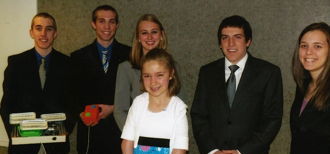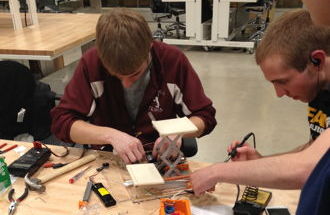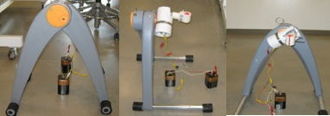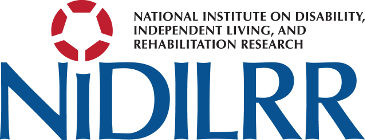Training Activities
Senior Design Projects
All senior engineering students at Marquette University are required to successfully complete a set of project-based capstone design courses. The design teams from the Senior Design Classes will identify customer needs, develop target specifications and potential designs, and construct and test prototypes. The process taught by the course complies with many of the requirements of ISO 900 and the FDA Quality Systems Regulations. Learning objectives and outcomes of the course also meet many ABET criteria. Projects that involve the use of human subjects are required to comply with the requirements of the Marquette University Investigational Review Board (IRB).
Up to three design teams per year will participate in the development of RERC products.
2012-2013 Senior Design Projects
First Place: Nourish II


Team Members:
- Maureen Ricken
- Brian Korves
- Ethan Pedretti
- Christian Knauss
- Alexius Metten
Student Consultants:
- Jack Rowland (Milwaukee Institute of Art and Design)
- Colleen Hardy (Milwaukee Institute of Art and Design)
Faculty Advisor:
- Dr. Brian Schmit
This project involved the development of a second generation assistive eating device to help an eleven year-old girl with arthrogryposis multiplex congenita (AMC) eat independently and in a socially acceptable way. The requirements for this device include a portability, stability, and intuitive use as well as the ability to accommodate many types of foods.
The device has three separate trays that carry food up to the user’s level via a scissor lift and two four-bar mechanisms. Unlike the previous device, these trays are compatible with nearly any type of food, especially those that are commonly found in school lunches. The device is relatively slim, with final dimensions of 12.75”x9.5”x3.5”. This will allow for the device to fit inside a standard laptop carrying case for easytransportation. The wide-base design also aids in maintaining the stability of the device, which remains stationary during use. The hand controller has been designed to allow easy access to all buttons and includes color coding for intuitive use.
The design was validated after showing the final prototype to the client. The design meets target specifications and customer needs, and performs as required. The prototype accommodates several food types, and the final manufacturing cost of $800 meets the cost goal of $1000.
Video of the scissor lift device in action
Video of the four-bar devices in action
This project was supported by R25 EB013070 from the National Institute of Biomedical Imaging and Bioengineering.
Second Place: Self Casting Fishing Rod
Team Members:
- Andrew Bielecki
- Paden Reed
- Joseph Radke
- Jon Seimetz
Student Consultants:
- Rhiannon Berres (Milwaukee Institute of Art and Design)
- Peter Jarroz (Milwaukee Institute of Art and Design)
Faculty Advisor:
- Dr. Said Audi
Sponsor:
- Fishing Has No Boundaries, Inc.
The non-profit group Fishing Has No Boundaries helps people with disabilities participate in fishing activities. They requested a device that can be used by their members that would allow them to safely cast a fishing rod. This would enhance the fishing experience and provide their members greater independence when fishing.

To create a device that could be adapted to the current fishing environment of the participants, a compact, adjustable design was developed that could mimic the motion of casting performed by a person without disabilities. The design incorporates a motor and gear system developed through model-based design and analysis. The final device is capable of casting a distance of just under 30 feet and can be used by children and adults with disabilities.
This project was supported by R25 EB013070 from the National Institute of Biomedical Imaging and Bioengineering.
Third Place: Communication Tool
Team Members:
- Shannon Miner
- Mitchell Ruble
- Kaleb Vinehout
- Lindsey Burleson
- Cheldon Brown
Faculty Advisor:
- Dr. Scott Beardsley
Sponsor:
- Milwaukee Center for Independence
An assistive device was requested by staff at the Milwaukee Center for Independence (MCFI) for a patient with unknown mental function. Due an accident he has only limited range of arm motion and lies in a horizontal wheelchair. He is also not able to talk and can only communicate via eye movement.
The staff at the Milwaukee Center for Independence requested a communication device that would allow him to control devices such as a computer, resulting in greater interaction with his peers and the world. The final design consists of an EMG/EEG headset with a gyroscopic motion detection system to allow for control of a cursor within a tablet computer. The client can signal a visual output by selecting various options and words from a personalized application and he can also enter free-text mode in order to communicate original thoughts via audio output.
This device can be used by children and others with communication disabilities and will allow them to more effectively and independently communicate with friends, family members, and caretakers.
This project was supported by R25 EB013070 from the National Institute of Biomedical Imaging and Bioengineering.
Senior Design Project
Initially, one senior design project was funded by the RERC. The assisted glove and elbow orthosis effectively sensed motion and assisted movement with an 8 ft cable distance using a prototype model. The proof of concept model validated the design parameters necessary to build a working system. The device was found to be suitable for use in a 3.0 Testla GE scanner for real time data acquisition. The design team learned to identify customer needs, develop target specifications and potential designs and how to construct and test a table top prototype.
Senior Engineering Design Project at Marquette University*
This project involves a cost-effective re-design of an upper limb assistive devices that could only measure elbow flexion and extension and hand opening and closing during functional magnetic resonance imaging (fMRI). The new device now allows patients to be assisted during elbow flexion and extension and hand opening while they are being scanned with an MRI (3.0 Tesla GE Scanner located at the Medical College of Wisconsin).
The design includes a glove that senses motion and assists when motion was not sensed. The elbow attachment (orthoses) senses elbow rotation and assists if motion is insufficient. The glove and elbow attachments are powered through a motor and cable system.
The design team has shown that the glove and elbow attachments can sense motion and assist movement by using a cable in a table-top system. The proof of concept model/prototype illustrates how the arm and hand are moved.

* This project was assisted through funding provided by the RERC on Technologies for Children with Orthopaedic Disabilities (Tech4POD).







